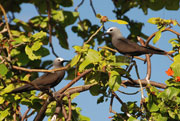Length: 32 cm / 13 inches
Wingspan: 60 cm / 24 inches
Introduction
The Lesser Noody is a fairly common seabird throughout the Seychelles Islands. They tend to breed in large numbers on the smaller rat-free islands, but are resident on most islands.
Identification
Lesser Noddys are a medium sized all-dark tern, with a whitish fore-crown which merges into a pale grey crown. They can be easily identified from the Brown Noddy by their smaller size, slighter build, shorter tail and wings and more rapid flight pattern.
When seen at close range, their plumage is significantly darker than the Brown Noddy and lacks any contrast in the wing. Their pale grey crowns extend further onto the nape than the Brown Noddy and the bill is much finer. Both species do however, share the same well marked, pale broken ring above and below the eye.
The plumage of the adult is completely dark sooty-grey except for a grey / white fore-crown and crown, which is much more extensive than the Brown Noddy, extending just below the front of their dark eyes and giving their faces a somewhat soft expression. Their black bills are long and thin and their legs and feet are blackish in colour, much shorter and weaker than the Brown Noddy.
Juveniles are similar in appearance to the adults, but their bills are much shorter and thicker. They have a more diffused white crown patch and paler brown edges to their wing coverts, which form faint bars.
Voice
The standard call to be heard from breeding colonies is a frequently uttered and rolling "kirriik" sound, however, Lesser Noddys can also be heard making an almost complaining "krrrrak!" sound. Nesting chicks tend to emit plaintive piping notes.
Behaviour
Lesser Noddys have a fairly weak flight pattern that consists of short and rapid beats. In flight, they sometimes dip to snatch small fish from the sea's surface, often feeding in dense flocks when conditions allow. Birds very often nest on the sea. When on land, they walk far less easily than the Brown Noddy and will periodically bow its head in a nodding fashion when approached by another noddy.
Breeding
Lesser Noddys most commonly breed in large colonies, with each pair typically only producing a single egg. The eggs are laid in a flimsy nest of leaves, of which the noddys place there. The initial onset of breeding varies depending on local feeding conditions; however, it typically occurs between April and June. Small numbers also nest during the northwest monsoon season, which occurs from December to February.
Photographs kindly provided by Doug Howes





